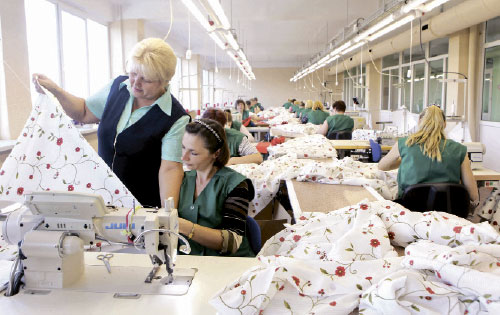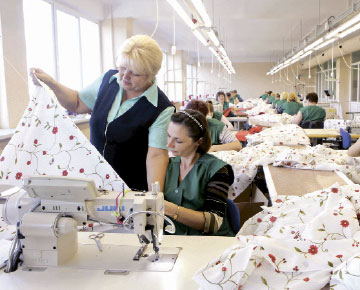Mogotex JSC is the largest manufacturer of textiles in Belarus and the CIS, producing over 60 million square metres of synthetic, cotton, mixed and crude fabrics annually. It also sews ready-made goods, which enjoy steady demand at home and abroad.

Mogotex opens new sewing production in Polotsk
One of its factories, in Bykhov, sews table linen and curtains for IKEA, while a branch in Polotsk makes service uniforms for the Defence and Emergency Ministries of Belarus and Russia, as well as special clothes for petroleum and extracting companies.
Last year, the enterprise manufactured Br944bn of goods, with more than 85 percent exported — to more than 20 countries, including Russia, Kazakhstan, Austria, Hungary, Latvia, Lithuania, Serbia and Mongolia.
The company is now preparing to enter the Latin American market, primarily Chile, having taken part in negotiations last year, including for the opening of a dealership. The Japanese market appears promising, being keen to acquire Mogilev fabrics for table linen, and for rail worker and fire brigade uniforms; Japanese trade houses are sending a delegation to Mogilev (as agreed at the Heimtextil Trade Fair). Meanwhile, orders for special clothes for builders are being negotiated though Mogotex-Baltic JV, alongside orders for forestry and oil processing worker uniforms.
Mr. Matievich notes that the geography of supplies is constantly expanding, explaining, “Mogotex has managed to respond promptly to market changes, producing popular technical textiles. Across the former USSR and beyond, we have 12 joint enterprises and 12 dealers promoting our goods. Our commodity distribution network is responsible for 60 percent of sales while fabrics for special, protective and official uniforms account for 70 percent of total production volumes.”
Mr. Matievich admits that the market is challenging and demanding, requiring Mogotex specialists to keep abreast of new trends by attending specialised expositions. The Heimtextil Expo is one of the most prominent for decorative fabrics while special and protective fabrics are the focus of such expositions as Germany’s A+A, Milipol in France, The Future Soldier in the Czech Republic, Safety and Labour Protection in Russia, and KADEX in Kazakhstan.
Since 2012, the enterprise has mastered 25 innovative production technologies, including fabrics fire, wind and water resistant, breathable, heat-reflecting, anti-mosquito, antibacterial and heavy-duty.
Mogotex is especially proud of its collaboration with Russian developers of clothes for cosmonauts, its Zvezda scientific production enterprise having created suit fabric for the crew of the ISS-34 space expedition, in December 2012. Mogotex’s light ‘breathable’ polyether was used for their production, developed in co-operation with specialists from Belarus, Russia and the EU.
Major technical re-equipment, costing $38m, which launched back in 2008, finished last October; aiming to make the company ‘flexible’ towards market requirements, it updated production of weaving, decoration and sewing, using equipment from Italy, Switzerland, Germany, Japan, France and Russia.
Regarding new prospects within the Eurasian Economic Union, the Director General of the textile enterprise stresses that legislation has already been created to ensure unhampered supplies of produce to Eurasian Economic Union markets. He notes, “The rest depends on our ability to efficiently sell goods, which we can do.”
By Svetlana Devyatkova











